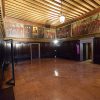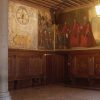The Chamber of Censors. The State Censors were set up in 1517 by Marco Giovanni di Giovanni, a cousin of Doge Andrea Gritti (1523-1538) and nephew of the great Francesco Foscari. The title and duties of the Censors resulted from the cultural and political upheavals that are associated with Humanism. In fact, the Censors were not judges as such, but more like moral consultants, being their main task the repression of electoral fraud and the protection of the State’s public institutions. On the walls hang a number of Domenico Tintoretto’s portraits of these magistrates, and below the armorial bearings of some of those who held the position.
The Chamber of the State Advocacies. This particular State Advocacy department dates from the time when Venice was a commune (12th century). The 3 members, the Avogadori, were the figures who safeguarded the very principle of legality, making sure that the laws were applied correctly. Though they never enjoyed the status and power of the Doge and the Council of Ten, the Avogadori remained one of the most prestigious authorities in Venice right up to the fall of the Republic. They were also responsible for preserving the integrity of the city’s patrician class, verifying the legitimacy of marriages and births inscribed in the Golden Book. The room is decorated with paintings representing some of the Avogadori venerating the Virgin, the Christ and various saints.
The “Scrigno” Room. The Venetian nobility as a caste came into existence because of the “closure” of admissions to the Great Council in 1297; however, it was only in the 16th century that formal measures were taken to introduce restrictions that protected the status of that aristocracy: marriages between nobles and commoners were forbidden and greater controls were set up to check the validity of aristocratic titles. There was also a Silver Book, which registered all those families that not only had the requisites of “civilization” and “honor”, but could also show that they were of ancient Venetian origin; such families furnished the manpower for the State bureaucracy – and particularly, the chancellery within the Doge’s Palace itself. The Golden and Silver Books were kept in a chest in this room, inside a cupboard that also contained all the documents proving the legitimacy of claims to be inscribed therein. The cupboard which one sees here nowadays extends around three sides of a wall niche; lacquered in white with gilded decorations, it dates from the 18th century.
The Chamber of the Navy Captains. Made up of 20 members from the Senate and the Great Council, the Milizia da Mar, first set up in the mid 16th century, was responsible for recruiting crews necessary for Venice’s war galleys. Contrary to what one might expect, the bulk of these crews were made up of paid oarsman drawn from the Venetian manufacturing industries. Another similar body, entitled the Provveditori all’Armar, was responsible for the actual fitting and supplying of the fleet. The furnishings are from the 16th century, while the wall torches date from the 18th century. The next room, now the bookshop, used to house the Lower Chancellery of the Doge’s Palace.


